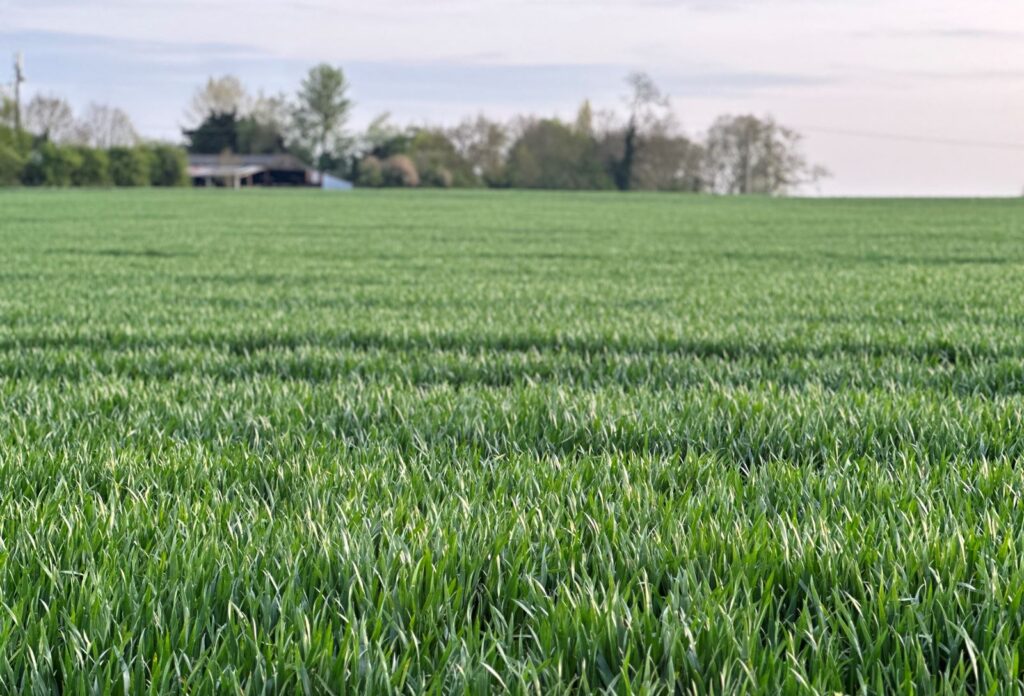Tackle the season’s challenges with the latest fungicide chemistry
16th May 2023
Cereal growers are being advised to use the latest fungicide chemistry to navigate disease challenges ahead of flag leaf spray applications this season.

Wheat growing in wet and warm conditions in May 2023.
In a typical year, spray applications aimed at protecting the flag leaf from Septoria and rust start from mid-May onwards. In this year’s crops, however, drilling date, variety choice, and weather conditions have all contributed to a huge divergence in growth stages and disease prevalence, according to Corteva’s field technical manager Craig Chisholm.
“Comparing crops across the country, we are seeing wheat which is only just having its T1 spray while other farms are preparing their T2 mixes.
“This will have been influenced by drill dates and varieties, but regardless of their growth stage crops generally look very good and have strong potential. The challenge will be getting T2 sprays on at the right time when there is not a great degree of uniformity.”
With the weather being volatile this spring, some T0 applications were abandoned altogether, while T1 sprays were carried out where weather windows presented themselves. Craig said this is being reflected in disease pressure, which continues to build as May’s temperatures rise.
“There is plenty of septoria in the base of the crops in the trials we have been looking at and the warm, wet weather will contribute to infection further up the plant,” he noted.
“Yellow rust has not been visible in many varieties until now – but is perhaps more evident in the south and west of England at the moment.”
Frontier’s crop production technical lead, Paul Fogg, added: “Septoria has not reached epidemic levels, but there is certainly more present than we’ve seen for a long time, probably driven by early drilling and temperatures over the winter.
“But autumn crops are looking good. Those who managed to execute their programmes this spring are definitely in the driving seat.”
To get on top of the season’s challenges, Mr Chisholm advises rowers to use fungicide chemistry with both protectant and curative qualities.
“Getting the timing of T2 sprays perfect is going to be a real challenge this year – it’s going to be easy to be a bit early or a bit late, so you need a fungicide that will stop disease taking hold, or act on any diseases that are present in the plant,” he pointed out.
According to Mr Chisholm, Univoq has a proven track record in delivering curative and preventative persistence against yield-robbing diseases. It is most commonly applied at the T2 fungicide timing – growth stage 39 – to help contain latent disease and protect the crop for the following four-to-six weeks.
Mr Fogg commented: “The season seems to be playing into the hands of the Inatreq molecule because of its disease control and longevity – it’s a long way to harvest so growers want something that’s going to stay the course.
“There will be decisions to be made around rates; 1.25l/ha is going to be a good starting point for many, but there are high-pressure situations already, and for those whose crops aren’t ready for a flag leaf spray yet, there is still time for pressure to build in this wet and warm weather.”
A standard application of Univoq at the T2 timing is 1.25l/ha, but rates can be increased up to 1.5l/ha or decreased to 1.1l/ha depending on variety and disease prevalence.
Corteva recommended the 1.5l/ha rate where disease pressure is already high, the T1 to T2 gap has become extended, or where greater control is required due to ongoing rainfall increasing infection rates.
2021 trials found that increasing the rate of Univoq from 1.25l/ha to 1.5l/ha under these circumstances gave a 0.15t/ha yield benefit worth £33/ha at current wheat values.
